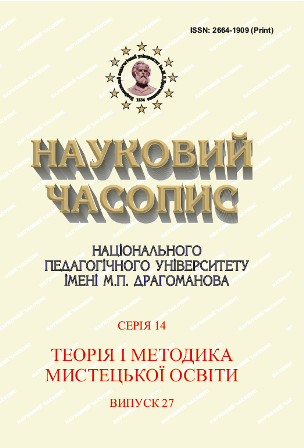Fundamentals of mastering national artistic traditions by the future teachers of music and choreography
DOI:
https://doi.org/10.31392/NPU-nc.series14.2019.27.18Keywords:
higher education methodology, education, national art tradition, pedagogical approach, choreographic educationAbstract
Relevance of the study is due, first of all, to the contradiction between the objective need of society for the preservation and development of national artistic traditions, on the one hand, and the low efficiency of the corresponding methods of mastering the aesthetic consciousness of students, on the other hand. Literature Review. The author relies on classical works devoted to the development of cultural tradition in music and choreographic education (B. Bartok, E. Balchitis, E. Bashich, K. Vasilenko, V. Verkhovinets, V. Dzhulyanu, V. Kovalyv, Z. Koday, M Lysenko, F. Lisek, K. Orff, B. Trichkov). The experience of using national artistic traditions in the practice of training teachers of music and choreography at pedagogical universities is taken into account (D. Sharikov, L. Androshchuk, A. Maksimenko, G. Nikola, T. Razumenko, O. Tarantseva, O. Chepalov). The purpose of this article is to determine pedagogical approaches, principles and methods of mastering national artistic traditions by future teachers of music and choreography Methodology. The methods of categorical analysis of the concept of “tradition”, of generalization and classification of specific approaches and principles of teaching are used. The method of explication of the concepts and provisions of philosophy, cultural studies, general art criticism, semiotics, hermeneutics in the field of training methodology for music teachers and choreography have been implemented. Results. An important mission of modern mass art education is to contribute fully to the preservation and development of the traditions of native national art, the formation of young people artistic sensitivity to the art of other peoples of the world, educating young people in the spirit of tolerance and respect for the cultural values of humanity. Modern teachers of music and choreography should be ready to fulfill this civilization mission. This implies the need to ensure that pedagogical universities have an effective process of mastering by future teachers of art a wide range of national artistic traditions. This task should be served by a technique based on organically inherent in the material itself and approaches that are natural for the set pedagogical purpose. These include: multicultural, artistic and integrative (polyartistic), hermeneutic and activity approaches. The methodology is based on the pedagogical principles of the dialogue of cultures, semiotic understanding of works of art as separate artistic signs and integral texts, contextual analysis of the semantics of works, a variety of forms and types of educational activity; developmental education concept. The practical implementation of these approaches and principles involves an appeal to the methods of culturological comprehension of traditional artifacts of art, comparative analysis, genre modeling of art culture, interactive learning, methods of pedagogy of cooperation. The general characteristic of the methodology provided in the article requires further development, in particular, concretization of the forms of the educational process, a description of methodological techniques, identification of pedagogical conditions for the optimal application of the methodology, establishment of selection criteria for artifacts representing specific national artistic traditions.
References
Bakhtin, M. (1979) Aesthetics of verbal creativity. Art, Moscow. [in Russian]
Buzova, O. (2004) Polіkhudozhnє vikhovannya yak zіb udoskonalennya musically prepared music maybutnіh readers of music: abstract dis. Kyiv. [in Ukrainian]
Weinstein. S. (1998). Comparative-historical method. Culturology. XX century. University book. Aletheia. SPb. [in Russian]
Gadamer Hans-Georg (1988). Truth and method. Translation from German. General edition and introductory article by B. N. Bessonov. Progress. Moscow. [in Russian]
Encyclopedia of Education (2008). Acad. sciences of Ukraine, head ed. V. G. Flint. Yurіnkom Inter. Kyiv. [in Ukrainian]
Kobzev A. (2006). The spiritual culture of China. In 5 volumes. East literature. Moscow. T. 1. Philosophy. P. 66-81. [in Russian]
New philosophical encyclopedia (2001). In 4 vols. Edited by V.S. Stepin. Volume 4. Thought. Moscow. - S. 87-88. [in Russian]
Rudnitska O. (2005). Universal pedagogy and Pedagogy of Art. Bogdan. Ternopil. [in Ukrainian]
Stepanova, L. (2018) Methodology of formulating artistic-hermeneutic competence of masters of the musical mystery and choreography. Abstract dis. Sumi. [in Ukrainian]
Philosophy: Encyclopedic Dictionary. (2004) Ed. A. Ivin. Gardariki. Moscow. [in Russian]
Jin Li. Cultural Foundations of Learning. East and West. (2015) Transl. from English A. Apollonova, T. Kotelnikova. Publishing House of the Higher School of Economics. Moscow. [in Russian]
Jin Xin Xin. Traditional culture and its role in the development of China's education. https://cyberleninka.ru/article/n/traditsionnaya-kultura-i-ee-rol-v-razvitii-obrazovaniya-kitaya [in Russian]
Shyp S. (2004) Iconic genre models of musical culture. Kyiv Musical Studies. Vol. 13. Kyiv. [in Russian]
Shcholokova O. (2013) Methodics of the World Art Culture. NPU in name of M.P. Dragomanov. Kyiv. [in Ukrainian]

